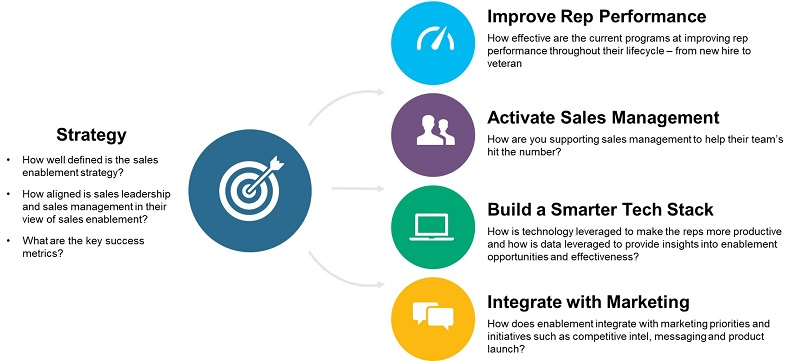ATD Blog
The Stages of Sales Enablement Maturity
Tue Feb 05 2019

Sales enablement is becoming a force to be reckoned with.
In the past several years, it’s grown from an offshoot of sales operations or training, tucked away in some corporate corner and shouldering all the responsibilities sales leaders and reps just didn’t have time for. Today, it’s increasingly seen as a mission-critical group. In our work, we see a correlation between the highest-performing sales organizations and sales enablement leaders who have a seat at the table.
Every sales enablement function lives somewhere along a maturity curve. Understanding where your team is on that curve is an anchor point for any planning effort. To set priorities for 2019, it’s important to understand where you are today. What are you dealing with? What are you trying to accomplish with the team you currently have? Where can you go?
Below are the four stages of sales enablement we see:
Stage One: Ad Hoc. The sales enablement strategy doesn’t really exist in any coherent way. It’s just a collection of (often random) activities.
Stage Two: Collaborative. Sales enablement activities take on a more programmatic feel, but are still only loosely aligned to overall sales objectives.
Stage Three: Integrated. Sales enablement is a core component of the sales strategy, with an emphasis on improving sales productivity and supporting field sales execution.
Stage Four: Transformative/Strategic. Sales enablement is seen as a strategic driver for sales success. It owns activation of field behavior change and is mission-critical for sales performance.

Obviously, the goal is to get to the Transformative level, where sales enablement is tightly connected to the sales strategy, and the sales leadership depends on sales enablement for execution of that strategy. But first you must determine where you are—realistically—before deciding how far you can go. It’s not possible to make the leap from Ad Hoc to Transformative, or even Integrated, in one jump. It needs to be a journey, building a solid foundation at each level to continue steady growth.

To do that, ask yourself questions about your sales enablement strategy, execution, technology, and impact to help understand your current sales enablement maturity. Each of the elements below help determine what’s critical to your organization to help you make progress along your journey.
1. Strategy
First, consider how well aligned the sales enablement goals are with the sales strategy. If there isn’t a sales enablement strategy (or strategic goals), the alignment isn’t very strong among the leadership. Ask:
How well aligned is the sales strategy among your leadership – not only the CEO, CSO, and COO, but also across the various sales leaders?
Do your activities connect under a strategy? If so, how would you define the core elements of that strategy?
Are there defined sales enablement goals? How do these goals map to the overall business objectives? Are there metrics? Do these metrics assess leading or lagging indicators?
2. Improve Rep Performance
Whether your sales enablement strategy is tightly connected to the sales strategy or there’s a lot of guesswork, the ability to improve rep performance can tell a lot about the maturity stage as well. Ask:
How are your seller enablement programs supporting the sales strategy? Is it reactive enablement or are you working with the sales teams to offer planned support?
How are you supporting sellers throughout their career lifecycle, from new hire to veteran status? How does your enablement approach change?
When are your programs being executed? Are these considered “sales enablement initiatives” or sales priorities? Sales enablement programs should not be seen as separate from sales initiatives; they should be interwoven into the broader sales strategy through common touchpoints and communication channels.
3. Activate Sales Management
Any rep enablement strategy is dead-on-arrival if management isn’t supporting it in the field. Mature organizations have specific enablement strategies for frontline leaders. Ask:
What is the expectation of the sales manager in the enablement ecosystem? How do they ensure accountability and deliver on the last mile of any program or initiative?
Is there a separate enablement focus for frontline sales managers? What enablement are they receiving to support their teams in the field?
How are managers engaged as a part of the enablement process? How are they equipped to lead change management in the field? High-performing organizations engage field leadership from enablement ideation through execution.
4. Build a Smarter Tech Stack
The enablement tech stack is constantly evolving, and the allure of the next shiny object is strong. Therefore, tech investment is sometimes used as a measurement for how invested the organization is in the sales enablement function. Ask:
Has your company made the necessary investments in sales technology to support your initiatives? If so, are there too many tools? Do they distract from valuable selling time? If not, what are the essential tools that will help the reps at key stages of the sales motion?
How are data and insights from the technology being used to inform business decisions?
How do sales leaders use data from sales enablement to make decisions?
Are you measuring the success of the sales enablement strategy, including the use of leading, lagging, or behavioral metrics? Which of these measures are most firmly within your control? What happens if you don’t measure it?
5. Integrate With Marketing
Sales does not operate in a silo. Enablement needs to serve as the organizational integrator to the field. To do so, engagement, collaboration, and alignment with marketing is critical. Ask:
How does marketing gain input from enablement (and vice versa) to develop marketing initiatives?
What role does enablement play in the launch and delivery of key marketing programs, including messaging, product launch, or competitive intelligence?
How aligned is sales, enablement, and marketing on the key objectives that will truly drive rep performance? Is the focus too broad or too narrow? What success metrics are shared among the three functions?
If you answered No more than Yes, you’re probably not as far along on the maturity curve as you’d like to be. Consider where your opportunities are to deliver support and have an impact on the sales organization. What challenges exist that you can rectify? What challenges do you see in the near future (or long term)? How can you prepare for those challenges and even get ahead of them?
Consider any risks involved with accomplishing your sales enablement goals, including aligning people who may not understand your function. The success of sales enablement requires alignment across multiple functions and stakeholders to be successful. Identify those stakeholders (including sales, finance, IT, marketing, and product development) and the role they’ll play in your process. Turn them into champions by letting them know ultimately your goal is to help them to realize their objectives.
Whether you're an army of one or you've got a dedicated global function with many resources, aspire to move one level at a time toward becoming—and remaining—a transformative force in your sales organization.
